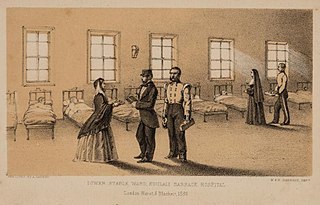 W
WThomas Jones Barker was an English historical and portrait painter.
 W
WEdward Ladd Betts was an English civil engineering contractor who was mainly involved in the building of railways.
 W
WLady Alicia Blackwood née Lambart,, the daughter of George Frederick Augustus Lambart, Viscount Kilcoursie (1789–1828) and Sarah Coppin, was an English painter and nurse, married to the Rev. James Stevenson Blackwood (1805–1882).
 W
WThomas Brassey was an English civil engineering contractor and manufacturer of building materials who was responsible for building much of the world's railways in the 19th century. By 1847, he had built about one-third of the railways in Britain, and by time of his death in 1870 he had built one in every twenty miles of railway in the world. This included three-quarters of the lines in France, major lines in many other European countries and in Canada, Australia, South America and India. He also built the structures associated with those railways, including docks, bridges, viaducts, stations, tunnels and drainage works.
 W
WMother Mary Francis Bridgeman R.S.M. was a nun with the Sisters of Mercy, a Roman Catholic religious congregation of women, founded in Ireland by Catherine McAuley and a pioneer nurse during the Crimean War of 1854-1856.
Betsi Cadwaladr, also known as Beti Cadwaladr and Betsi Davis, worked as a nurse in the Crimean War alongside Florence Nightingale, although their different social backgrounds were a source of constant disagreement. Her name today is synonymous with the Betsi Cadwaladr University Health Board, the largest health organisation in Wales. In 2016, she was named as one of "the 50 greatest Welsh men and women of all time". and was placed ahead of such famous Welsh individuals as the singer Tom Jones, the actor Anthony Hopkins, T.E. Lawrence and Ivor Novello.
 W
WThomas William Chenery was an English scholar and editor of the British newspaper The Times. His diplomatic background and choice of capable reporters helped to revive the paper's reputation for international news.
 W
WFrances Isabella Duberly was an English soldier’s wife who wrote a journal of her experiences on campaign in the Crimean War and the Indian Rebellion of 1857 which was afterwards published. Her husband, Captain Henry Duberly, was paymaster to the 8th Royal Irish Hussars, part of the British light cavalry that took part in the Charge of the Light Brigade. Duberly's journal of her time in the Crimea was published as Journal Kept During the Russian War. It not only includes eye-witness accounts, but is also a record of gossip and rumours circulating in the British Army.
 W
WRoger Fenton was a British photographer, noted as one of the first war photographers.
 W
WAlexander William Kinglake was an English travel writer and historian.
 W
WSir Guilford Lindsey Molesworth (1828–1925) was an English civil engineer.
 W
WFlorence Nightingale, was an English social reformer, statistician and the founder of modern nursing. Nightingale came to prominence while serving as a manager and trainer of nurses during the Crimean War, in which she organised care for wounded soldiers. She gave nursing a favourable reputation and became an icon of Victorian culture, especially in the persona of "The Lady with the Lamp" making rounds of wounded soldiers at night.
 W
WSir Samuel Morton Peto, 1st Baronet was an English entrepreneur, civil engineer and railway developer, and, for more than 20 years, a Member of Parliament (MP). A partner in the firm of Grissell and Peto, he managed construction firms that built many major buildings and monuments in London, including The Reform Club, The Lyceum, Nelson's Column and the new Houses of Parliament; which made him a millionaire.
 W
WJames Robertson (1813–1888) was an English gem and coin engraver who worked in the Mediterranean region, and who became a pioneering photographer working in the Crimea and possibly India. He is noted for his Orientalist photographs and for being one of the first war photographers.
 W
WSir William Howard Russell, was an Irish reporter with The Times, and is considered to have been one of the first modern war correspondents. He spent 22 months covering the Crimean War, including the Siege of Sevastopol and the Charge of the Light Brigade. He later covered events during the Indian Rebellion of 1857, the American Civil War, the Austro-Prussian War, and the Franco-Prussian War.
 W
WMary Jane Seacole was a British-Jamaican nurse, healer and businesswoman who set up the "British Hotel" behind the lines during the Crimean War. She described this as "a mess-table and comfortable quarters for sick and convalescent officers", and provided succour for wounded servicemen on the battlefield, and nursed many of them back to health. Coming from a tradition of Jamaican and West African "doctresses", Seacole displayed "compassion, skills and bravery while nursing soldiers during the Crimean War", through the use of herbal remedies. She was posthumously awarded the Jamaican Order of Merit in 1991. In 2004, she was voted the greatest black Briton.